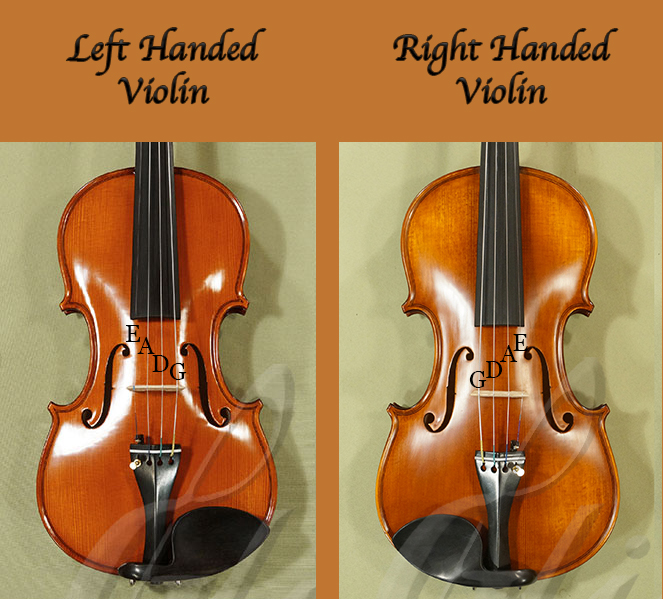Left-Handed Violins: Everything You Need to Know
If you are a left-handed person who wants to play the violin, you might be wondering if there is such a thing as a left-handed violin. The answer is yes, there are violins that are specially designed for left-handed players. But what are they exactly, and how are they different from right-handed violins? In this article, we will answer these questions and more, so you can decide if a left-handed violin is right for you.
What is a Left Handed Violin?
A left-handed violin is a violin that is made to be played by people whose dominant hand is the left hand. It is a mirror image of the traditional violin, which means that everything is reversed. The strings, the pegs, the chin rest, the bridge, the sound post and the bass bar are all on the opposite side of the instrument. The left-handed violin is held in the right hand and rests on the right shoulder. The bow is held and coordinated with the left hand.
How are Left Handed Violins Different from Right Handed Violins?
Left handed violins are different from right handed violins in several ways. The most obvious difference is the orientation of the instrument and the way it is played. As mentioned above, the left-handed violin is held in the right hand and rests on the right shoulder. The bow is held and coordinated with the left hand.
While the instrument itself is a mirror image of a traditional violin, the lowest string (G string) is still positioned closest to the musician's chin, and the highest string (E string) is farthest away. This is facilitated by the position of the peg holes in the peg box and the shape of the bridge.
The first internal element that defines the left handed violin is the bass bar, which is placed under the right leg of the bridge. The sound post is placed under the left leg of the bridge. Additionally, the chin rest and shoulder rest need to be positioned differently to accommodate the left-handed player.
Left handed violin players have to deal with some challenges that right handed violinists don't face, such as finding suitable teachers (not every teacher will agree to teach a student who wants to play a left-handed violin), accessories, and instruments.
Who Plays Left Handed Violins?
Left handed violins are played by people who prefer to use their left hand for tasks that require fine motor skills and coordination, such as writing, drawing, or playing musical instruments. Some people are born with a natural preference for their left hand, while others develop it due to injury or disability that affects their right hand.
There are many famous musicians who play or have played left handed violins, such as:
• Charlie Chaplin: The legendary actor, comedian, and filmmaker was also a talented musician who composed many of his own film scores. He played the violin left handed, as well as other instruments such as piano and cello.
• Rudolf Kolisch: The Austrian-American violinist was a leader of several string quartets and a professor of music at Harvard University. He was one of the few accomplished violinists who played left handed, the result of a youthful injury to the fingers of his right hand.
• Paul McCartney: The Beatles legend is one of the most influential and successful musicians of all time. He plays several instruments left handed, including guitar, bass, piano, and violin.
Can a Left Handed Person Play a Right Handed Violin?
The answer is definitely, "Yes!"
A person may choose to play a left-handed violin if they are naturally left-handed and find it more comfortable or intuitive to play with their left hand on the fingerboard and their right hand on the bow. This decision is based on personal preference and comfort. However, it's worth noting that the majority of violinists, including left-handed individuals, play a standard right-handed violin without making any modifications.
In a traditional right-handed violin, the left hand controls the finger placement on the fingerboard, while the right hand is responsible for bowing the strings. Left-handed individuals who choose to play a standard right-handed violin often adapt to the instrument's configuration and find it suitable for their needs. This approach allows them to have access to a wider range of violin models, resources, and learning materials, as left-handed violins are less common and can be more challenging to find.
Why Do People Play Left Handed Violins?
People play left handed violins for various reasons. Some of them are:
• Comfort: Playing a left handed violin feels more natural and comfortable for some left handed people who are used to doing everything with their left hand. They feel that they can be more expressive, and their bodies pick up and incorporate instructions easier if not challenged.
• Convenience - After an injury or accident: Playing a left handed violin can be more convenient for some people who have limited access or mobility in their bodies due to injury or disability. For instance, a person who injured their left shoulder will not be able to hold the violin on the right shoulder for extended periods, and the injury may even worsen with time from repetitive stimulation. Moving the violin on the left shoulder, which means playing a left-handed violin, may offer them a second chance at following their dream of playing the violin.
• Challenge: Playing a left handed violin can be a fun and rewarding challenge for some people who want to try something different or improve their musical skills. This is a rare instance, though. :-) I have only encountered one person in my entire life who chose to play the violin left handed as a personal challenge.
What are The Challenges of Playing a Violin Left Handed?
• Availability of Instruments: Left-handed violins are relatively rare compared to standard right-handed violins. It can be challenging to find a high-quality left-handed violin, and they may be more expensive or have a limited selection compared to right-handed instruments.
• Limited Instrument Choices: Left-handed violinists may have fewer options when it comes to choosing a violin. They might have to settle for a lower quality instrument or compromise on their preferences due to the limited availability.
• Difficulty in Group Settings: When playing in an ensemble or orchestra, left-handed violinists may face challenges in terms of positioning and alignment. They might need to adjust their seating arrangement or angle to accommodate their left-handed playing, which can disrupt the standard formation.
Where Can You Buy a Left Handed Violin in Canada?
Left handed violins are not as common or widely available as right handed violins, but they are not impossible to find either. Gliga started to make left handed violins in the early 2000. Gliga is probably one of the early contemporary violin makers who decided to start making left handed violins in response to the market demand. Here is a link to our entire collection of 4/4 left handed violins: https://www.violinslover.ca/left-handed-violins
Conclusion
Left handed violins are violins that are designed and built for left-handed players. They are different from right handed violins in the orientation of the instrument and the way it is played. Left handed violins are played by people who have a natural or acquired preference for their left hand, and who have various reasons for choosing this type of instrument. If you are a left-handed person who wants to play the violin, you can play both, a traditional or a left handd violin. If you think that playing a left handed violin will make your musical journey more enjoyable and fulfilling, then we would be happy to assist you in finding the perfect left handd violin for you.

